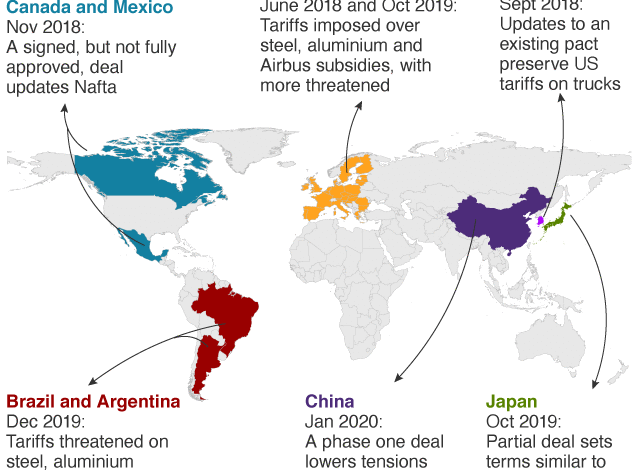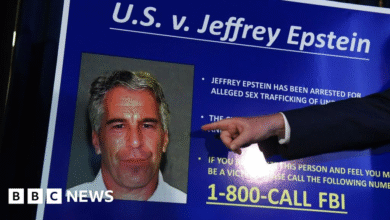Trump Trade Deals: New Announcements Before July 9 Deadline

Trump trade deals are at the forefront of economic conversations as the administration prepares for a flurry of important announcements. Treasury Secretary Scott Bessent has revealed that several trade negotiations are set to unfold over the next 48 hours, highlighting urgency among foreign officials to finalize agreements before the impending July 9 deadline. With elevated U.S. tariffs looming, Bessent noted an influx of proposals in his inbox, showcasing a shift in international attitudes towards trade with the United States. President Donald Trump has suggested that up to 15 corresponding letters and deals will be sent out, potentially reshaping the tariff rates applicable to many nations. As the countdown to these significant trade developments begins, the spotlight is firmly on how these actions will affect the wider economy and America’s global trade relations.
In recent days, the administration’s focus on trade agreements and tariff adjustments has taken center stage, prompting discussions about America’s economic strategies. The urgency surrounding these negotiations reflects a critical moment for foreign trade relations, especially as the July 9 deadline approaches for reinstating certain tariff levels. Economic officials, including Secretary Bessent, emphasize that the landscape is rapidly changing, with many international partners eager to engage in fresh discussions. As President Trump vows to send out both letters and establish new trade conditions, the upcoming weeks are expected to be pivotal in determining the future of U.S. tariffs on imports. This evolving scenario signals a significant recalibration of trade policies which could have lasting impacts on the economy.
Upcoming Trump Trade Deals: What’s on the Horizon?
The Trump administration is poised to make several significant trade announcements in the next 48 hours according to Treasury Secretary Scott Bessent. These announcements are critical as they coincide with the impending July 9 deadline, which serves as a pivotal time for U.S. tariffs on numerous imports to ramp up. Bessent emphasized the urgency that foreign trade officials are feeling as they hustle to close deals and finalize trade negotiations before these tariff rates become effective again. The pressure is on, as heightened tariffs on imports could drastically affect bilateral trade relationships and impact the global market.
President Trump has hinted at a wave of communication, specifically “tariff Letters, and/or Deals,” expected to be dispatched starting Monday at noon ET. This flurry of activity indicates not only a robust approach to trade but also a reaction to the shifting climate of international negotiations. The administration’s commitment to engage with trade partners suggests a strategic move to curve the U.S. deficit while initiating agreements that can be seen as beneficial both domestically and internationally.
Impact of U.S. Tariffs on Trade Negotiations
The impending reinstatement of elevated U.S. tariff rates has sparked a renewed urgency in trade negotiations, as indicated by Secretary Bessent’s comments on CNBC. As countries scramble to finalize agreements before the July 9 deadline, the landscape of international trade is rapidly shifting. Potential trade partners are adjusting their strategies, leading to a surge in proposals aimed at securing favorable terms with the U.S. This high-stakes environment showcases the pivotal role tariffs play in shaping economic relationships, as countries weigh their options in light of upcoming tariff rates.
With the backdrop of possible changes to U.S. tariffs, the negotiation landscape has transformed significantly. Bessent mentioned an influx of new offers and proposals as international partners recognize the impending shifts in tariff rates. The administration’s flexibility, as highlighted by Bessent’s remarks about country-specific tariff rates to be temporarily postponed until August 1, allows for a window of opportunity for negotiators to strike advantageous deals. This potential for negotiation signifies the complex interplay between trade policies and economic diplomacy, which could define the U.S.’s trade standing in the global arena.
The Role of Scott Bessent in Trade Discussions
Treasury Secretary Scott Bessent has emerged as a key figure in the ongoing discussions surrounding Trump’s trade policies. His insights on the accelerated push to finalize trade deals reflect not just the urgency of the situation, but also his strategic position within the administration. Bessent’s experience and understanding of financial markets position him as a vital communicator between trade officials and the White House, ensuring that objectives are met within tight timelines as the July 9 deadline approaches.
Bessent’s announcements about upcoming trade deals underline an intentional effort by the Trump administration to engage previously disengaged trade partners. His comments about receiving numerous proposals indicate a shift in international perceptions, as countries rethink their negotiations in light of the looming changes in U.S. tariffs. This development highlights Bessent’s critical role in navigating the complexities of trade negotiations that are central to the administration’s economic strategy.
Tariff Rates and Their Future: What to Expect
The upcoming changes to U.S. tariff rates have generated a mix of anticipation and uncertainty among trade partners. As Treasury Secretary Bessent indicated, multiple trade letters and agreements are expected to be communicated to various countries, signifying a structured approach towards adjusting tariffs. This proactive stance suggests that the Trump administration is not only aiming to redefine its trade tactics but is also signaling its intent to maintain strong economic ties with key global players amid evolving trade dynamics.
The July 9 deadline looms large as a crucial date for imposing newfound tariff rates, casting a shadow over ongoing negotiations. Countries that adequately prepare for these changes can position themselves favorably, while those that linger in indecision may face increased costs. With President Trump’s promises of tariff letters and potential deals, the coming days will be instrumental in determining the trajectory of U.S. trade policy and its implications for global trade relations.
Understanding the Trade Landscape: A Shift in Dynamics
The current trade landscape reflects a dynamic shift, one that is notably influenced by the Trump administration’s tariff policies. The aggressive approach to enforcing U.S. tariffs has led to a reevaluation of international trade agreements as countries scramble to adapt. This change in dynamics calls into question how nations will approach future trade negotiations, as the looming threat of increased tariffs could lead to either escalated cooperation or heightened tensions.
As we analyze the implications of the upcoming tariff rates, it becomes clear that the interplay between U.S. trade policy and global economic relations is becoming increasingly intricate. Trade negotiations are now framed around the urgency of deadlines like July 9, which not only impacts economic planning but also diplomatic engagements. Understanding these nuances is crucial for stakeholders as they navigate a transformed trade environment characterized by both opportunities and challenges.
How Trump Trade Deals Are Shaping Economic Forecasts
The strategic initiatives of the Trump administration regarding trade deals are reshaping economic forecasts across multiple sectors. By announcing imminent trade agreements and tariff changes, the administration is setting a precedent for how trade negotiations will unfold in the future. Economists and analysts alike are keeping a keen eye on these developments, as the outcomes of such deals could significantly influence market conditions and investor behavior in the months ahead.
Furthermore, the interplay between anticipated trade deals and tariff adjustments offers unique opportunities for businesses and investors. Understanding these factors will enable key players to make informed decisions regarding investments and operations within the global market. The commitment to fostering robust trade relationships under the Trump administration may lead to improved market stability, benefitting both the U.S. and its trading partners.
Bilateral Agreements: The Path Forward
The focus on bilateral agreements as part of the Trump administration’s trade strategy signifies a move towards tailor-made solutions that directly address specific trade issues between the U.S. and other countries. These agreements may offer a more controlled approach to trade, allowing for targeted negotiation on tariffs that cater to the unique needs of each trading partner. As Bessent pointed out, the administration has been eager to engage in discussions that could yield mutual benefits before the next implementation of tariff rates.
Bilateral agreements also serve to strengthen relationships with key nations, fostering an environment conducive to collaborative economic growth. With heightened tariffs looming, these agreements could offer possible exemptions or reduced rates that align with mutually advantageous terms. Thus, the ongoing negotiations may not only influence market trends but could also redefine long-standing relations based on strategic economic interests.
Navigating the Tariff Deadline: Strategies for Trade Partners
As the July 9 deadline approaches, trade partners are strategizing on how to navigate the implications of the reinstated U.S. tariffs. With Secretary Bessent’s announcement of potential letters and deals to follow, countries need to evaluate their trade positions critically. Establishing a proactive stance in these negotiations can mitigate the impact of rising tariffs and secure favorable terms for all parties involved.
Trade officials are being urged to utilize the remaining days leading to the deadline to finalize agreements that not only respond to tariff increases but also lay the groundwork for sustainable trade practices moving forward. The shifting dynamics of U.S. tariffs create both challenges and opportunities, and those trade partners who can quickly adapt to these changes will find themselves at a significant advantage in the evolving global market.
Long-term Implications of Trump’s Tariff Strategy
The long-term implications of the Trump administration’s tariff strategy will be felt across the global economic landscape, with potential shifts in trade alliances and patterns. As the U.S. continues to assert itself through tariff negotiations, other countries may rethink their trade strategies in response. This could lead to a landscape where nations prioritize creating partnerships that can withstand tariff pressures, ultimately reshaping international trade as we know it.
Moreover, ongoing tariff discussions could serve as a means for the U.S. to leverage its economic power in negotiations, influencing not just trade, but international relations on a broader scale. Businesses will need to adapt to these evolving conditions, constantly re-evaluating their approaches to mitigate risks associated with tariffs while seizing opportunities presented by new trade agreements.
Frequently Asked Questions
What are the latest Trump trade deals involving U.S. tariffs before the July 9 deadline?
The Trump administration is expected to announce several trade deals and tariff rates in the coming days, particularly before the July 9 deadline when elevated U.S. tariffs will be reinstated. Treasury Secretary Scott Bessent indicated that foreign trade officials are racing to finalize agreements amid these changes.
How do U.S. tariffs under Trump impact trade negotiations with partner countries?
U.S. tariffs under the Trump administration have significantly influenced trade negotiations, as countries are eager to reach agreements before the July 9 deadline. These tariffs create a sense of urgency, compelling trade partners to align their proposals with U.S. trade policies in order to avoid higher tariff rates.
What role does Scott Bessent play in the Trump administration’s trade negotiations?
Scott Bessent, as Treasury Secretary, plays a crucial role in the Trump administration’s trade negotiations. He has highlighted the administration’s plans for trade announcements, signaling that new deals and tariff letters will soon be dispatched to U.S. trade partners as part of ongoing discussions.
Are there any specific tariff rates announced by the Trump administration?
While specific tariff rates were not detailed at this time, Treasury Secretary Scott Bessent mentioned that letters outlining new tariff rates would be sent to trade partners. These letters will communicate the rates and any potential for renegotiation before the impending implementation of tariffs on August 1.
What happens if trade deals are not finalized by the July 9 deadline?
If trade deals are not finalized by the July 9 deadline, the Trump administration will reinstate higher U.S. tariffs, which may complicate trade relationships and further affect international trade dynamics. This has prompted foreign countries to expedite their negotiations with the U.S.
How will the Trump administration communicate new trade deals?
The Trump administration plans to communicate new trade deals through tariff letters. These letters will serve as formal notifications of the terms and rates applicable to imports from trade partners, allowing for some negotiation if desired.
Why is the July 9 deadline important for Trump’s trade deals?
The July 9 deadline is critical because it marks the reinstatement of elevated U.S. tariffs on numerous imports. As a result, the urgency to negotiate and finalize trade deals has increased, as countries seek to avoid higher tariff rates that could impact their exports to the United States.
What indicators suggest that trade negotiations under the Trump administration are progressing?
Recent comments from Treasury Secretary Scott Bessent indicate increased activity in trade negotiations, with a flurry of new proposals submitted by foreign trade officials. This uptick suggests that trade partners are eager to reach agreements ahead of the July 9 tariff deadline.
| Key Point | Details |
|---|---|
| Announcement of New Trade Deals | Treasury Secretary Scott Bessent announced that the Trump administration plans to unveil ‘several’ trade-related announcements within the next 48 hours. |
| Deadline for Newly Negotiated Deals | Trade officials are hurrying to finalize deals before July 9, when elevated U.S. tariffs will be reinstated. |
| Tariff Letters and Deals | Trump indicated that up to 15 letters to U.S. trade partners outlining new tariff rates will be sent out between Monday and Wednesday. |
| Update on Tariff Collection Dates | Bessent confirmed that country-specific tariff rates will not be collected until August 1. |
| Nature of Tariff Letters | The letters will serve as standard communication thanking countries for trading and outlining their specific tariff rates. |
| Ambiguity in Tariff Changes | Trump provided an unclear response regarding when tariff rates would change, stating, ‘They’re going to be tariffs.’ |
Summary
Trump trade deals are set to take center stage as the administration hints at several new agreements and tariff announcements in the coming days. With a pressing deadline of July 9 for finalizing negotiations to avoid elevated tariffs, the Trump administration is potentially reshaping trade relations. The push to expedite these trade deals signifies a critical moment for U.S. foreign trade dynamics. As the world watches closely, the outcomes of these negotiations will undoubtedly have lasting implications on the U.S. economy and its global trade partnerships.




